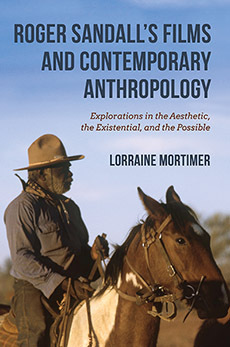The American, October 8, 2009
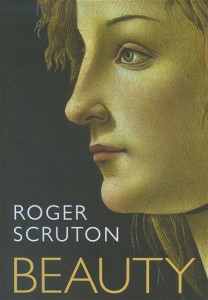 At first glance our two authors could hardly be more unlike. Judging from his new book Beauty, Roger Scruton’s idea of a pleasing view would probably be the Wiltshire countryside circa 1750 — a scene like that on his website banner, with perhaps some red-coated riders, left, and a fox, courant, hurrying into a copse. Turning next to Denis Dutton’s Darwinian The Art Instinct, and in sharp contrast, a congenially paintable vista for that author might be Ethiopia’s Omo Valley, circa 1,000,000 BC, with Stone Age hunters chasing antelope over Africa’s green hills.
At first glance our two authors could hardly be more unlike. Judging from his new book Beauty, Roger Scruton’s idea of a pleasing view would probably be the Wiltshire countryside circa 1750 — a scene like that on his website banner, with perhaps some red-coated riders, left, and a fox, courant, hurrying into a copse. Turning next to Denis Dutton’s Darwinian The Art Instinct, and in sharp contrast, a congenially paintable vista for that author might be Ethiopia’s Omo Valley, circa 1,000,000 BC, with Stone Age hunters chasing antelope over Africa’s green hills.
Yet for all this I expect that across a wide range of cultural artefacts and activities their tastes would chime. They each believe in the best that has been written, painted, or composed, and they know what it is. Both of them grieve to see entire traditions of thought and work being dishonored and trashed. “A determination to shock or puzzle has sent much recent art down a wrong path,” Dutton writes in his Introduction. “A Darwinian aesthetics can restore the vital place of beauty, skill, and pleasure as high artistic values.” High artistic values are exactly what Scruton would also like to see restored and it’s encouraging to see two such thoughtful books about art appear within weeks of each other.
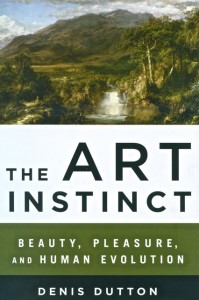 Though perhaps this conjunction is not so surprising after all, because the place of the arts in society, and the general condition of the arts, have long been seen as a gauge of civilised morale. Matthew Arnold’s Culture and Anarchy pioneered this critical tradition in the 19th century — but we’ve come a long way since then. Once confined to the bohemian margins, artists and their adversarial values have in the last century moved steadily closer to the center, while increasing their political clout, a development that drew the worried attention of such distinguished commentators as Irving Kristol, Daniel Bell, and Jacques Barzun.
Though perhaps this conjunction is not so surprising after all, because the place of the arts in society, and the general condition of the arts, have long been seen as a gauge of civilised morale. Matthew Arnold’s Culture and Anarchy pioneered this critical tradition in the 19th century — but we’ve come a long way since then. Once confined to the bohemian margins, artists and their adversarial values have in the last century moved steadily closer to the center, while increasing their political clout, a development that drew the worried attention of such distinguished commentators as Irving Kristol, Daniel Bell, and Jacques Barzun.
In The Use and Abuse of Art Barzun observed that the “invidious, resentful relation of art to life has become general and unremitting.” Characterizing “the sensibility of the sixties” and its typical creative works Daniel Bell wrote of its “violence and cruelty” and of “an anti-cognitive and anti-intellectual mood” that has hardly diminished since, something that also concerns Scruton and Dutton today. When Irving Kristol wrote that abandoning the constraints of the Protestant ethic caused “virtue to lose her loveliness”, who would have thought that “loveliness” (by which we mean the entire ethically ambiguous realm of the aesthetic) would soon assume the virtue that virtue itself had lost? Sceptics wondered whether the triumph of the aesthetic represented the moral defeat of the bourgeoisie.
That is doubtless an exaggeration — but we’re getting ahead of ourselves here. Both the books in question have more positive and elevating themes and purposes. About our ideas on beauty, and why we like what we like, they are primarily philosophical, and seek to explain and defend the place of cultural refinement in a life well lived — and Dutton might say in any life worth living. His Darwinian argument is that music and literature and much else are deeply rooted in human nature itself. This in turn raises questions about sources and origins. Where do we find the earliest signs of aesthetic sensibility? Is it in a primordial appreciation of nature? Can Africa’s Omo Valley be really where it all began?
Landscape and universals
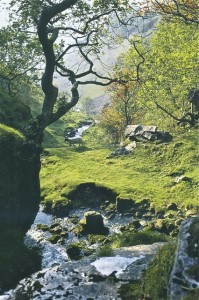
Yorkshire Dales, photo: Geoff Lund
You don’t travel far with either author before the question is raised whether trees and rivers and hills are universally appealing. For most ordinary men and women (though varying with levels of articulacy) this could range from a hushed “look at that!” to my own excited reaction not long ago. Driving one morning around a curve in a country road I saw a sunlit view — rolling hills, low light, willows by a stream — and “God that’s beautiful!” burst unbidden from my lips. There may have been sheep and cows too. Not a very original expostulation you will say, but the question is this: was it as spontaneously unmeditated as it seemed to me at the time? While the words “instant” and “instinct” sound similar, do they here mean much the same thing?
Dutton would unequivocally answer “yes” and give his reasons. Evolutionary psychology (or EP) suggests that landscape preferences are deeply ancient and originated in Palaeolithic times, and that critical judgements about suitable real estate started way back then. However “disinterested” the appreciation of beauty either is or should be, according to Immanuel Kant, a beautiful Pleistocene landscape was always a matter of lively ancestral concern, and it was valued for straightforward down-to-earth reasons: available water, fertility, and abundant game. According to The Art Instinct the deep source of my excitement as those sunlit hills came into view was a primordial pattern of instinctive response. What’s surprising, however, is that with rather more equivocation Roger Scruton seems to agree.
According to the author of Beauty, Immanuel Kant also thought our response to nature was spontaneous and unstudied, and it’s not hard to see what he meant. Standing on the lip of the Grand Canyon you are at once struck dumb with wonder. Views of nature please us immediately and without concepts said Kant — and speaking for myself I’d have to say that’s how I felt on that morning drive. Unaware what was coming, and attending to nothing but a winding road, I was immediately riveted by the view, and my reaction was as unconceptualized as only passive visual sensation on the threshold of attention can be. Kant also maintained that “the primary exercise of judgement is in the appreciation of nature”, a statement glossed by Scruton when he adds that “a faculty that is directed towards natural beauty therefore has a real chance of being common to all human beings, issuing judgements with a universal force.”
Now unless I’m mistaken this tells us that a sense of “natural beauty” is “universal” and shared by “all human beings” — pretty much a matter of human nature you’d think, or what Kant himself called a sensus communis. In the course of his discussion Scruton twice refers to “our species”, and when mankind as a species is invoked can the universalities of origins, sources, evolution, genes, homo sapiens, Darwin, the lot, be far behind? Our mastery over nature converted the primaeval world “into a safe and common home for our species” Scruton writes on page 61. Then on page 65, elaborating on the contrast between the ‘free’ beauties of nature and the ‘dependent’ beauties of art, he tells us that “there is something plausible in the idea that the contemplation of nature is both distinctive of our species and common to its members…”
If the contemplative appreciation of nature is distinctive of our species perhaps it is also instinctive in our species: doesn’t this take us close to the evolutionary view? Dutton and Scruton start out from very different premises, to be sure, yet aren’t they talking about much the same thing?
The failings of EP
But no — Scruton won’t have any of that. Agreeing with an Australian philosopher, the late David Stove, he dismisses evolutionary psychology as “Darwinian fairytales”. As for The Art Instinct, although it receives bibliographical mention at the back of Scruton’s book, neither the work nor its argument is engaged directly (both titles appeared in 2009, The Art Instinct a little before Beauty). Instead, two other proponents of evolutionary psychology, Ellen Dissanayake and Geoffrey Miller (whose contributions are described in Dutton’s book) are made to represent evolutionary aesthetics overall.
Both thinkers however are too idiosyncratic to fill this role, and might be seen as easy game. In Homo Aestheticus and elsewhere Dissanayake had proposed that art arises from the human need to decoratively “make special” our ceremonies and religious rites. Making special by means of ornamental art supposedly encourages group cohesion, thereby conferring a collective advantage. Scruton allows that the theory has something to be said for it, but says it “falls critically short of explaining what is distinctive of the aesthetic”. Again, in The Mating Mind Geoffrey Miller pushes Darwinian fitness theory further perhaps than is entirely safe: like the peacock’s tail, both beauty and art itself are lumped in with all the other phenomena of sexual selection and reproduction. Not unreasonably, Scruton comments that “Even if the peacock’s tail and the Art of Fugue have a common ancestry, the appreciation elicited by the one is of a completely different kind from the appreciation directed at the other.”(p37)
Whatever evolutionary psychology may say, or evolutionists like Denis Dutton might think (so Roger Scruton argues), it is man’s good fortune to have been divinely touched with rationality, for “it is the very capacity for reasoning that distinguishes us from the rest of nature.” Reasoning about things we know and have experienced enables us to make the fine discriminations required in aesthetic judgement; reasoning allows us to enter into the mind of the artist and understand his intentions — what the poet was driving at, what the painter meant. After which on page 38 Scruton sweeps the whole Darwinian argument aside:
“As things stand, the evolutionary psychology of beauty offers a picture of the human being and human society with the aesthetic element deprived of its specific intentionality, and dissolved in vague generalities that overlook the peculiar place of aesthetic judgement in the life of the rational agent.”
The evolutionist’s response
So that’s that. But is it also “how things stand” with Denis Dutton? Within his Darwinian scheme of explanation, does a painter or poet know what he’s doing, mean what he says, and can we understand his intentions ourselves? The Art Instinct has in fact a lot to say about intention and intentionality, and it is neither vaporous nor vague.
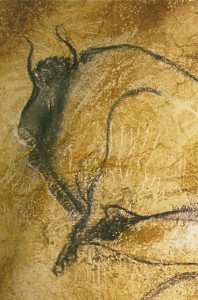
Bison, Chauvet Cave
Fitness theory — the signs of vigor and male prowess that brilliant tail feathers and menacing antlers and fighting ability show — is important in Dutton’s argument, and it places conscious intention and visibly displayed individual achievement at the center of evolutionary aesthetics. Whoever drew the highly distinctive images of bears, bison, rhinoceros and lions at Chauvet Cave about 32,000 years ago knew exactly what he was doing, and must have been greatly admired for his skill. Moreover, Dutton’s thinking about Palaeolithic origins in the past is informed by research among tribes-people in the present. Evidence of self-conscious artistic intention is something he encountered doing fieldwork in New Guinea villages, where “the work of individual dancers, poets, and carvers is a focus of fascinated attention”.
From Scruton’s comment above you might think that evolutionary psychology had as one of its aims (or anyway one of its effects) an anthropological “abandonment of the author function”, a denial of individual agency, a view of abstract historical process without individual influence or meaning, of predetermining forces that supervene and displace the writer’s mind. Not so says Dutton — quite the reverse. It is in novels, poetry, and drama that individual demonstrations of superior skill, style, and imaginative intelligence provide some of evolution’s most persuasive indicators:
We admire clarity, accuracy, and relevance in realistic, descriptive uses of language and regard these qualities as showing that a speaker possesses desirable intellectual qualities. Fictional creations — stories, jokes, and ornamented speech, such as poetry — are similarly judged.
Behind every act of speaking, descriptive or artistic, looms the idea of the fitness test. Human beings are continuously judging their fellows in terms of the cleverness or banality of their language use.
Skilled employment of a large vocabulary, complicated grammatical constructions, wit, surprise, stylishness, coherence, and lucidity all have bearing on how we assess other human beings. Intentionally artistic uses of language are particularly liable to assessment in terms of what they reveal about the character of a speaker or writer.
Listing twelve “signal characteristics of art considered as a universal, cross-cultural category,” Dutton emphasizes the universal admiration for individual skill and virtuosity; the way relatively static traditional styles are the measure against which individual innovations are tested, registered, and adopted for mainstream performance; the role of novelty and creativity as “the locus of individuality or genius in art, referring to that aspect of art that is not governed by rules or routines”; and the potential for “expressive individuality” wherever tired conventions produce boring work for weary audiences.
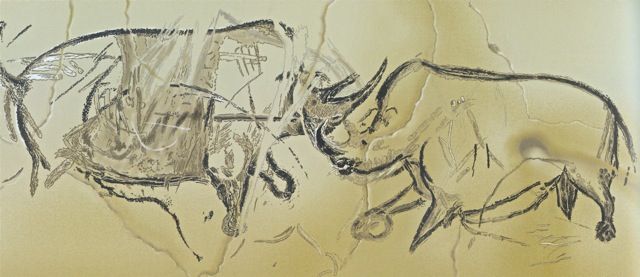
Rhinos, Chauvet Cave
As for the common argument that artistic individuality is a “Western construct” (a post-modern claim, and certainly not Scruton’s), drawing again on his field experience Dutton declares this to be false: “individual talent and expressive personality is respected in New Guinea as elsewhere.” So standing back a little we can see that the supposedly contradictory propositions about universality and individuality are not so incompatible after all. Yes: on the one hand a universal “art instinct” is the biological foundation of music, painting, and literature. Yes: on the other hand, the particularity of individual genius is indispensable for climbing art’s highest peaks. What’s not to like?
Sex and beauty according to Scruton
No account of beauty would be complete without the effect of sexual attraction upon our judgement of personal appearance, and since Roger Scruton has already written much on this matter it was to be expected that he would also have something to say in his latest book. Kantian ethics demand that individuals be treated as ends, not means: in his discussion of feminine beauty it becomes important for Scruton to explain how a disinterested aesthetic admiration for the nude can be distinguished from mere lubricity.
One view of sex suggests that the machinery of reproduction is a divine joke, sent by God to perplex us when we should be just getting on with our lives. This is the comic view. Another and more tragic understanding is that the theatre of sexual desire exists for the enactment of spiritually uplifting moral drama — a serious matter that should be discussed by philosophers (some of them bachelors like Kant) suffering all the pains of restraint. Sometimes they are trying to restrain homosexual impulses, like Socrates. Sometimes their impulses are heterosexual, like Saint Augustine’s. One way or the other it’s no laughing matter.
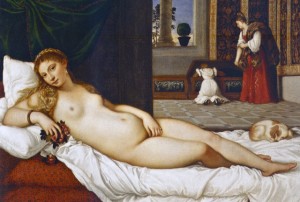
Venus of Urbino, Uffizi Gallery
In Sexual Desire Roger Scruton devotes over 400 pages to this topic. In Beauty it receives 41 pages out of 197, over a fifth of the whole, where he tells us how to adopt a suitably contemplative attitude toward naked women in art and life. It is not clear to me how useful this is. He tells us that the Venus of Urbino — “that most provocative of Titian’s female nudes” — is to be sharply distinguished from Manet’s Olympia, the author’s judgement being that “the hand on the thigh of Manet’s Olympia is not the hand that Titian paints, schooled in innocent caresses and resting with a fairy touch: it is a raw, tough hand that deals in money, that grips far more readily than it strokes…” As Scruton strains to distinguish the kind of work he approves as reflecting “conjugal passion” (Titian) from what he disapproves as incipiently pornographic (Manet), drawing on the bachelor sage of 18th century Königsberg to adjudicate (Immanuel Kant), we enter the philosophical zone of subjects that are not objects, objects that would prefer to be subjects, and subjects that are not really objects despite being treated as if they were — like Manet’s model for Olympia. But this is more for adepts and cognoscenti.
Scruton also regards the historic distinction between “fantasy” and “imagination” as important. “True art appeals to the imagination,” he writes, “whereas effects elicit fantasy. Imaginary things are pondered, fantasies are acted out. Both fantasy and imagination concern unrealities; but while the unrealities of fantasy penetrate and pollute our world, those of the imagination exist in a world of their own, in which we wander freely and in a condition of sympathetic detachment.” This is all very well — and not unpersuasive — until one looks at the author’s humorless discussion of Titian’s Venus of Urbino. In contrast to Botticelli’s Venus, Scruton observes, with Titian’s Venus we are no longer in heaven but in a down-to-earth realm of
“domestic safety and conjugal passion… She reclines among her drapes in full confidence of her personal right to them, immersed in a life that is larger, deeper, more inscrutable than the moment alone. Her body is revealed to us, but she does not show it to us — she is not as a rule conscious of being watched, save perhaps by a dog or a cupid whose calm unembarrassability merely emphasizes the fact that voyeurs cannot trouble her peace of mind, which is also a peace of body. She is not in a state of excitement…
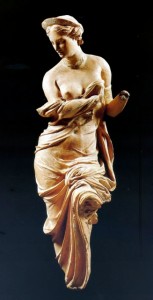
Myrina Aphrodite, Pergamon Museum
What is this? Fantasy or imagination? Who knows? Though it does bring to mind Mrs Patrick Campbell’s thrust at her unmanageably loquacious vegetarian friend Bernard Shaw: “some day you’ll eat a pork chop Georgie, and then God help all women.”
No doubt some useful distinction between the healthily erotic and a sick lubricity can be made, as Scruton tries to do — the contemporary curse of pornography is real enough. And no doubt Kant’s distinction between means and ends helps us understand what has happened. I do feel however that if all this is of such grave moral concern to Scruton, then one would like to see him turn his attention away from the temptations of reclining nudes. The serene dignity of partially draped standing figures, exemplified by the Hellenistic Venus de Milo and the Myrina Aphrodite, remind us that antiquity did some things rather better.
Sex and beauty, the evolutionary view
The ordinary reader might easily feel there is little to be said here. Whatever the humorist James Thurber may have been thinking of when he asked plaintively “Is Sex Necessary?”, sex is certainly needed for evolution. After all, evolution is about reproduction, reproduction is about sex, and Darwin’s thoughts about sexual selection by mate choice are the starting point for any consideration of why some features of human anatomy and some shapes are preferred to others. Here the peacock’s tail returns in all its glory: any specimen strong enough to provide the walking squawking platform for such an extravagant display proclaims its biological fitness to peahens for miles around. And it has been confirmed experimentally that the better peacocks with the better tails have the better genes.
Natural selection is slow, passive, and excludes the unfit. Sexual selection is by comparison fast, active, and both includes and unites the fit. For anyone interested in what human fitness looks like there are well-known studies of waist-to-hip ratios showing what is required for female attractiveness. “Healthy premenopausal women will have a ratio of .67 to .80” writes Dutton, “hardly an hourglass, but possibly a Coke bottle; this body shape is regarded as “feminine’ and attractive by men.” We are told that there are sound statistical reasons for regarding this ratio as biologically adaptive, “as women who display a waist-to-hip ratio on the .7 or .8 range are significantly more fertile than women closer to the healthy male ratio of around .9.”
Yet the curious thing about modern evolutionary aesthetics is that this attention to physique is only the start. One could almost argue that it takes off from the point where Roger Scruton falters — perplexed by moral issues, and whether he should allow Olympia, clothed or unclothed, into his living room. Instead, evolutionary aesthetics concentrates on the remarkable creative attributes of artists and the dazzling achievements of conscious artistry. Not Olympia, but Manet the artist, is the focus of concern; and not the real-life Victorine Meurent, who modelled for Manet’s painting, but the innovative skills of painters who have historically portrayed at least as many women with their clothes on as off. That, I feel fairly sure, is true of Manet.
While anatomical excellence is fundamental, human mental development and the emergence of language brought a whole new range of attractive intellectual features, all convertible into art. Minds were expanding, and artistic virtuosity not only gave access to our minds, it enhanced our attractiveness too. Gorgeous paintings gradually came to supplement gorgeous anatomy; sharp wit and sharp dialog supplemented physical prowess. Muscly warrior castes may have thought such developments effete, distracting, and incomprehensible, but in evolutionary terms they were no less effective in determining mate choice.
Dutton writes: “Grammar, syntax, word choice, appropriateness, coherence, relevance, speed of response, wit, rhythm, ability to toy with words, and originality all play a part. Taken together, these skills and qualities of mind constitute eloquence, and the admiration of eloquence is solidly on the list of human universals.” So it is that from a foundation of words, and intelligence, and with the operation of sexual selection, the manifold glories of story telling and literary enchantment eventually grew — from tribal tales about hunting bears to the Odyssey, to Shakespeare, to Tolstoy and Thomas Mann.
Minimal beauty and the sense of order
A photograph in Beauty shows a place setting at a dinner table. A folded napkin, tied neatly with a bow, sits on a plate alongside a knife and fork, with wine glasses ready nearby and lighted candles in the background. A suspicion that this heralds a chapter on etiquette soon proves mistaken (though I look forward to neat little bows on our domestic napkins in future). The accompanying discussion is among the more interesting features of Scruton’s book, and it underlines two things. First, that an elementary sense of visual order lies at the foundation of the pictorial arts; second, that when the author writes of civilization providing “a safe and common home for our species”, this is the sort of home he has in mind. His species is cultural rather than zoological, and much of it can be found within a leisurely day’s ride of what Englishmen call the Home Counties, not too far from London.
“There is an aesthetic minimalism exemplified by laying the table, tidying your room, designing a web-site” Scruton writes, and however remote in scale and significance these are from the maximalism of Tolstoy’s War and Peace, or Beethoven’s Ninth, in each case we want things to “look right”. Perhaps it is unnecessary to be reminded of this amidst the welter of magazines dealing with house and home and the plethora of newspaper supplements about “design”, especially when more and more people call themselves “designers”. But because he feels that the more mundane features of modern life also belong in a general theory of beauty, Scruton usefully reminds us that “a nice pair of shoes or a tasteful piece of wrapping paper” are more important to many people’s daily lives than the great works of art that may, if we are lucky, fill our leisure hours. They both confirm and express “our desire for harmony, fittingness and civility.” (p12)
His ability to say helpful things about shoes and wrapping paper shows the practical turn of mind that is one of Scruton’s assets. His chapter on “Everyday Beauty” also treats gardens, distinguishing their aesthetic enjoyment from the open spaces of landscape. Kant had argued that unlike works of art landscapes “owe their appeal not to symmetry, unity, and form, but to an openness, grandeur and world-like expansiveness, in which it is we and not they that are contained.” In contrast, writes Scruton, gardens are extensions of the human world that mediate “between the built environment and the world of nature.” Gardens have been made and enjoyed for human purposes in every civilization. Does this make them also aesthetic universals? Perhaps there’s a case for such a view:
This attempt to match our surroundings to ourselves and ourselves to our surroundings is arguably a human universal. And it suggests that the judgement of beauty is not just an optional addition to the repertoire of human judgements, but the unavoidable consequence of taking life seriously, and becoming truly conscious of our affairs. (p82)
But what is true of politics and economics is also true of aesthetics. A tension exists between the claims of the collective and the claims of the individual; between the communal requirements of cultural tradition and the personal ambitions of artists. A small town with an established architectural style that has grown and matured over centuries may not appreciate the egoistic audacities of Frank Gehry or Sir Norman Foster. The residential community may want something that fits in, that does not stand out; something where age-old patterns are honoured, not violated; a design in which the humble harmonies that make a house a home should be preserved. In brief, it may not want a big glass-walled egg in the town square.
The aesthetics of everyday life lead ineluctably to the place of consensus and tradition. Scruton places a high value on collective agreement whenever settled understandings of hearth and home are threatened by a spirit of “tear down and start again” — regardless of whose hearths and homes are pulverised. He argues the conservative case for a civilized life that consists, fundamentally, in providing congenial homes for people of taste in a social order “that does nothing to disturb our perceptions but which radiates a simple message of calm sociability.”(p92) His eloquence on behalf of this ideal is moving, but seems perhaps a mite too bland. It needs a dash of bitters — the sort of thing provided by Veblen’s Theory of the Leisure Class. Whatever it does for the modern economy, and it plainly does a great deal, conspicuous consumption also “disturbs our perceptions” and does nothing at all for “calm sociability”. Some awareness of this is perhaps implied by the following contrast:
Our discussion implies that aesthetic judgement can be exercised in two contrasting ways: to fit in and to stand out.
Fitting in or standing out (and in the arts is there now a more popular way of standing out than being outrageous?), passively conforming or seeking attention, unconsciously accepting conventions or actively “making special”, these psychological alternatives have all sorts of implications — or they do for a Darwinian approach to art. Although he might be loath to admit it, Scruton’s thoughts on such matters as novelty vs. tradition relate to cognitive evolution, and to our organized understanding of the world around us. This begins with the perception of patterns, and their interpretation, and the way living organisms respond to regularity and order.
Cognitive evolution
It is over thirty years since E. H. Gombrich’s book The Sense of Order: a Study in the Psychology of Decorative Art, where he advocated “an evolutionist view of the mind”. Such a view, he wrote, “has become inescapable since the days of Darwin”, adding that it is “thanks to the researches of ethologists during the last few decades that more is known about inborn reactions for which animals are undoubtedly ‘programmed’ than even Darwin could have surmised.” His particular interest was how perceived regularities in the natural world (of light, sound, heat and cold, pressure, physical resistance) enable ‘cognitive maps’ to be built up — systems of “coordinates on which meaningful objects can be plotted.” Such maps were essential to survival; they enabled living things to orient themselves in space; and he set out to connect the resulting “sense of order” with a theory of decorative design.
What did this order consist of? Amidst the blooming buzzing confusion of the sensory flux organisms detect patterns — patterns in time and intensity, in duration and force. The simple association of mere pleasure and pain might lead to valuing one pattern over another — but how did primitive organisms think? You might say the amoeba “developed a hypothesis” about the danger of approaching too close to something hot. Or you might say it “told itself a story” about the danger of hot things. Anyway the neurological rudiments of thought have been there, along with elementary representations, for millions of years. As James Hurford writes in his 2007 The Origins of Meaning, a natural evolutionary approach means “that mental representations of things and events in the world came before any corresponding expressions in language; the mental representations were phylogenetically prior to words and sentences.”
When referential language eventually came along, words and concepts multiplied to manage the patterns (Gombrich drew on information theory to explicate avian behavior: the signal to noise ratio of the peacock’s tail enabled it to cut through the surrounding redundancy). With pattern recognition came an embryonic aesthetic sense: “In both space and time, in sight and sound,” writes Brian Boyd, “we sense beauty in ‘the rule of order over randomness, of pattern over chaos’.” Before long Homo sapiens got the idea that playfully imaginative story-telling was even more fun than description, and you could have horses with wings (Greece), serpents with feathery plumes (Mexico), or priapic heroes that travelled underground (Australia). After that the arts really took off. On page fifteen of Boyd’s 2009 On the Origin of Stories he writes that “We can define art as cognitive play with pattern.” This is universal among the higher mammals, he says, adding that play itself
evolved through the advantages of flexibility; the amount of play in a species correlates with its flexibility of action. Behaviors like escape and pursuit, attack and defense, and social give-and-take can make life-or death differences.
But it is “attention” and the incessant demand for attention by art and artists that Boyd emphasizes perhaps most of all. “Art dies without attention”, he writes, adding twenty pages later that “attention provides the selective mechanism of art. If a work of art fails to earn attention, it dies.” All of us seek attention, we are told, as a mark of acceptance, respect, and status; primatological studies show that “the more dominant a primate, the more attention others direct toward him or her”; and he then pursues this topic through an analysis of one of the most famous epic narratives of all time, the Odyssey. Asking rhetorically what Homer’s work can offer us after two thousand five hundred years, he answers that “it can stress the importance of attention itself… a sine qua non of all art. Art can affect minds over time because it so compulsively engages out attention.”
Art’s importunity appears to Boyd unproblematic, perhaps because he sees it in such heartily positive terms. Something else he approves are communal benefits both at human and pre-human levels. We learn that chimpanzees celebrate community through excited cries or matching movements and “derive a rich emotional response from harmonizing attention among themselves through pattern and rhythm, chant and dance,” while historian William McNeill “recalls the ‘sense of pervasive well-being’ that he experienced in the army drill yard in 1941 — ‘a strange sense of personal enlargement; a sort of swelling out, becoming bigger than life, thanks to participation in collective ritual.’” The implication being that a thorough-going incorporation into collective life is essential for everyone, that attention-getting is a social necessity in life as in art, and that ever-expanding creativity of every kind is desirable. As he writes on page 123, “For us, artistic creativity offers a good in itself.”
From making special to making vile
While walking today I saw a sticker saying “Art makes me feel unsafe.” I wonder who wrote it and why? Can it be that some art today is indeed unsafe and has a genuinely menacing purpose and character? In which case does evolutionary aesthetics throw light on the matter? As we saw at the beginning, although they differ in various ways both Roger Scruton and Denis Dutton are equally dismayed by the contemporary trashing of high culture. In his Introduction Dutton complains that “a determination to shock or puzzle has sent much art down a wrong path”, and he plainly feels uncomfortable with some modern trends. Scruton’s misgivings go deeper, and as an example of what he fears he describes a Berlin production by Calixto Bieito of Mozart’s Abduction from the Seraglio (Die Entführung aus dem Serail) set in a Berlin brothel…
with Selim as pimp, and Konstanze one of the prostitutes. Even during the most tender music, the stage was littered with couples copulating, and every excuse for violence, with or without a sexual climax, was taken. At one point a prostitute is gratuitously tortured, and her nipples bloodily and realistically severed before she is killed. The words and the music speak of love and compassion, but their message is drowned out by the loudly orchestrated scenes of murder and narcissistic sex that litter the stage.
As Scruton adds, this “flight from beauty” into sordid sadistic ugliness can be found in many aspects of contemporary culture. There is a self-conscious “desire to spoil beauty in acts of aesthetic iconoclasm.” Desecration is his word for it, and he argues that for a certain kind of nihilistic mind “desecration is a kind of defence against the sacred, an attempt to destroy its claims. In the presence of sacred things our lives are judged and in order to escape that judgement we destroy the thing that seems to accuse us.”
While I am not religious I tend to agree. And I regret to say that evolutionary aesthetics appears to offer little defence against such nihilism. As the inquiries of critics like Irving Kristol and Jacques Barzun suggested years ago, the purely egoistic activities of attention seeking and making special, and the hyper-individualistic drive for supreme distinction, increasingly take place in a moral void. Ellen Dissanayake writes (Homo Aestheticus, page 59) that “specialness may be strangeness, outrageousness, or extravagance” (my emphasis). So it seems that however outrageous it is, it’s still art, and the sacralizing of making special is fully compatible with the desecration of making vile. Having implied that attention-getting creativity is a good in itself (virtually the summum bonum) Brian Boyd adds correctly that “Evolution does not aim at creativity. It aims at nothing.”
For his part Denis Dutton looks critically at modernism and says its assumption that “culture can give us a taste for just anything at all” is false. In other words, we have a kind of built-in moral resistance to the runaway pathologies now visible in the arts. I am very glad to hear this, and I hope it is true, because if it’s not, then Calixto Bieito and the film director Lars Von Trier represent the future — the Showbiz incarnation of that sick outrageousness that infects the entertainment industry today. And if that happens I suspect art will make us feel unsafer still. It needn’t, and it shouldn’t, but it may.
Note: Although the argument remains the same, the text presented here is slightly longer than that appearing in The American last October.

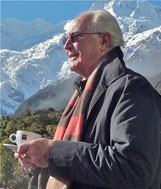 An Australian writer living in Sydney, Roger Sandall is the author of The Culture Cult (2001), a study of romantic primitivism and its effects. His work has appeared in a number of places including Commentary, The American Interest, Encounter, The New Criterion, The American, Sight and Sound, Quadrant, Art International, The New Lugano Review, The Salisbury Review, Merkur, Mankind, Visual Anthropology, and Social Science and Modern Society.
An Australian writer living in Sydney, Roger Sandall is the author of The Culture Cult (2001), a study of romantic primitivism and its effects. His work has appeared in a number of places including Commentary, The American Interest, Encounter, The New Criterion, The American, Sight and Sound, Quadrant, Art International, The New Lugano Review, The Salisbury Review, Merkur, Mankind, Visual Anthropology, and Social Science and Modern Society.